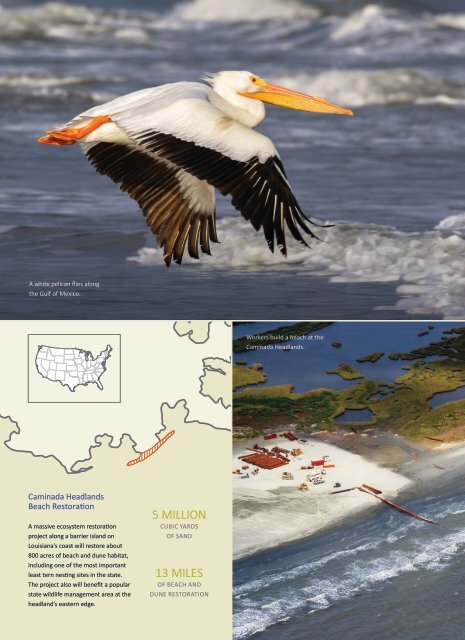NATIONAL FISH AND WILDLIFE FOUNDATION
2015_annual_report
2015_annual_report
You also want an ePaper? Increase the reach of your titles
YUMPU automatically turns print PDFs into web optimized ePapers that Google loves.
BUILDING RESILIENCE ALONG THE<br />
GULF OF MEXICO<br />
A colossal effort to rebuild and restore 13 miles of coastline along<br />
the Gulf of Mexico ranks as the largest conservation project ever<br />
undertaken by the state of Louisiana and NFWF.<br />
This massive conservation project is unfolding on the Caminada Headlands, a beach<br />
and marsh system that serves as a barrier between the Gulf of Mexico and Port Fourchon,<br />
Louisiana’s southernmost port and one of the nation’s most important energy hubs.<br />
Over the past 100 years, the Caminada Headlands has experienced extensive shoreline<br />
erosion. This loss of land has destroyed natural habitats critical not only to shorebirds,<br />
fish and crustaceans, but also to the culture of southern Louisiana.<br />
A white pelican flies along<br />
the Gulf of Mexico.<br />
Workers build a beach at the<br />
Caminada Headlands.<br />
The degradation of this barrier island system also puts Port Fourchon — and the nation’s<br />
energy supply — at far greater risk from hurricanes. Port Fourchon supplies nearly 18 percent<br />
of the country’s entire oil supply, and its tenants service an estimated 90 percent of the oil<br />
and gas exploration in the Gulf of Mexico. A 2014 study found that a 21-day interruption of<br />
operations at Port Fourchon would cost $11.2<br />
billion in lost sales at U.S. firms, $3.2 billion<br />
Barrier island ecosystems such as those being<br />
in lost household earnings and 65,502 jobs<br />
rebuilt on Caminada are also integral aspects of local throughout the country.<br />
communities and culture in southern Louisiana.<br />
Rebuilding such a critical landscape at such<br />
— Chett Chiasson, executive director of the Port of Fourchon an immense scale — a new beach about 100<br />
yards wide and 13 miles long — requires<br />
monumental efforts. When the project is complete, workers will have dredged more than<br />
5 million cubic yards of sand from Ship Shoal, an 8,000-year-old submerged barrier island<br />
27 miles away in the Gulf of Mexico. Sand fencing and planting of native vegetation will<br />
help stabilize the new dunes, providing stopover sites for migrating songbirds and nesting<br />
habitats for shorebirds.<br />
17<br />
The historic project has been divided into two stages; NFWF funded the second phase with<br />
$144.5 million from its Gulf Environmental Benefit Fund in 2014. A significant portion of the<br />
dredging and construction work for this phase was accomplished in 2015.<br />
Caminada Headlands<br />
Beach Restoration<br />
A massive ecosystem restoration<br />
project along a barrier island on<br />
Louisiana’s coast will restore about<br />
800 acres of beach and dune habitat,<br />
including one of the most important<br />
least tern nesting sites in the state.<br />
The project also will benefit a popular<br />
state wildlife management area at the<br />
headland’s eastern edge.<br />
5 MILLION<br />
CUBIC YARDS<br />
OF S<strong>AND</strong><br />
13 MILES<br />
OF BEACH <strong>AND</strong><br />
DUNE RESTORATION<br />
“Landscape-level projects such as the Caminada Headlands restoration are incredibly<br />
challenging, but they’re critical to the future of Louisiana,” said Chett Chiasson, executive<br />
director of the Port of Fourchon. “Barrier island systems such as those being rebuilt on<br />
Caminada are integral aspects of local communities and culture in southern Louisiana. These<br />
headlands also provide a natural buffer from catastrophic weather events, which is critically<br />
important to the resiliency of regional and national economies.”


